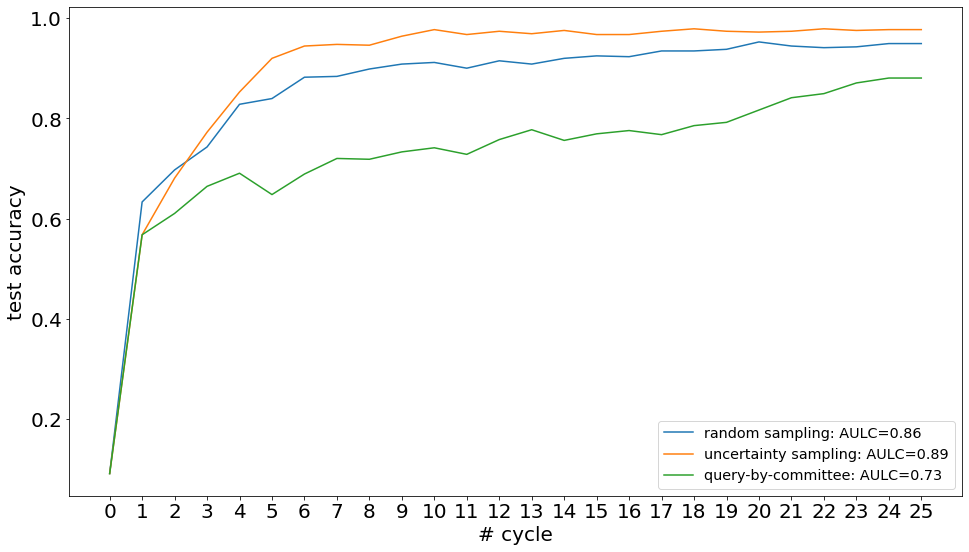Deep Pool-based Active Learning: Scikit-activeml with Skorch#
In this brief tutorial, we show an example use-case of our package skactiveml with the Python package skorch, which is a scikit-learn wrapper for Pytorch models. This way, we are able to implement and test deep learning models in combination with query strategies implemented in our framework.
[1]:
import matplotlib as mlp
import matplotlib.pyplot as plt
import numpy as np
import torch
import warnings
from copy import deepcopy
from skactiveml.classifier import SklearnClassifier
from skactiveml.pool import UncertaintySampling, QueryByCommittee, RandomSampling
from skactiveml.utils import call_func
from sklearn.datasets import load_digits
from sklearn.ensemble import VotingClassifier
from sklearn.model_selection import train_test_split
from sklearn.preprocessing import StandardScaler
from skorch import NeuralNetClassifier
from torch import nn
mlp.rcParams["figure.facecolor"] = "white"
MISSING_LABEL = -1
RANDOM_STATE = 0
FONTSIZE = 20
torch.manual_seed(RANDOM_STATE)
torch.cuda.manual_seed(RANDOM_STATE)
warnings.filterwarnings("ignore")
Loading Digit Data Set#
For simplicity, we load the digit data set available through the sklearn package. The 8x8 images show handwritten digits from 0 to 9 and the task is to recognize the digits in the images.
[2]:
# Load digit data set.
X, y_true = load_digits(return_X_y=True)
# Visualize first 10 images.
fig, axes = plt.subplots(figsize=(15, 5), nrows=1, ncols=10)
for i in range(10):
axes[i].set_title(f'Digit: {y_true[i]}', fontsize=FONTSIZE)
axes[i].imshow(X[i].reshape((8, 8)))
plt.show()
# Standardize data.
X = StandardScaler().fit_transform(X)
# Reshape samples to n_samples x n_channels x width x height to fit skorch
# requirements.
X = X.reshape((len(X), 1, 8, 8))
# Set data types according to skorch requirements.
X, y_true = X.astype(np.float32), y_true.astype(np.int64)
# Identify list of possible classes.
classes = np.unique(y_true)
# Make a 66-34 train-test split.
X_train, X_test, y_train, y_test = train_test_split(
X, y_true, train_size=0.66, random_state=RANDOM_STATE
)

Convolutional Neural Network Ensemble#
In a next step, we define a convolutional neural network (CNN) ensemble consisting of multiple base CNNs with different learning rates and initializations.
[3]:
# Define base module.
class ClassifierModule(nn.Module):
def __init__(self):
super(ClassifierModule, self).__init__()
self.conv_layer = nn.Sequential(
nn.Conv2d(1, 32, kernel_size=3, stride=1, padding=0),
nn.ReLU(),
nn.MaxPool2d(kernel_size=2, stride=2)
)
self.dense_layer = nn.Linear(288, len(classes))
self.outpout = nn.Softmax(dim=-1)
def forward(self, X):
X = self.conv_layer(X)
X = X.reshape(X.size(0), -1)
X= self.dense_layer(X)
X = self.outpout(X)
return X
# Create list of three base CNNs.
learning_rates = [1.e-3, 1.e-2, 1.e-1]
estimators = []
for i, learning_rate in enumerate(learning_rates):
net = NeuralNetClassifier(
ClassifierModule,
max_epochs=100,
lr=learning_rate,
verbose=0,
train_split=False,
)
net.initialize()
estimators.append((f'clf {i}',
SklearnClassifier(
estimator=net, missing_label=MISSING_LABEL,
random_state=i, classes=classes)
)
)
# Creat voting ensemble out of given ensemble list.
ensemble_init = SklearnClassifier(
estimator=VotingClassifier(estimators=estimators, voting='soft'),
missing_label=MISSING_LABEL, random_state=RANDOM_STATE, classes=classes
)
Active Classification#
For our ensemble, we evaluate three different query strategies, i.e., random sampling, uncertainty sampling, and query-by-committee, regarding their sample selection. For this purpose, we start with zero labels and make 25 iterations of an active learning cycle with a batch size of 20.
[4]:
# Define setup.
n_cycles = 25
batch_size = 20
qs_dict = {
'random sampling': RandomSampling(random_state=RANDOM_STATE, missing_label=MISSING_LABEL),
'uncertainty sampling': UncertaintySampling(random_state=RANDOM_STATE, missing_label=MISSING_LABEL),
'query-by-committee': QueryByCommittee(random_state=RANDOM_STATE, missing_label=MISSING_LABEL),
}
acc_dict = {key: np.zeros(n_cycles + 1) for key in qs_dict}
# Perform active learning with each query strategy.
for qs_name, qs in qs_dict.items():
torch.manual_seed(RANDOM_STATE)
torch.cuda.manual_seed(RANDOM_STATE)
print(f'Execute active learning using {qs_name}.')
# Copy initial ensemble model.
ensemble = deepcopy(ensemble_init)
# Create array of missing labels as initial labels.
y = np.full_like(y_train, fill_value=MISSING_LABEL, dtype=np.int64)
# Execute active learning cycle.
for c in range(n_cycles):
# Fit and evaluate ensemble.
acc = ensemble.fit(X_train, y).score(X_test, y_test)
acc_dict[qs_name][c] = acc
# Select and update training data.
query_idx = call_func(
qs.query, X=X_train, y=y, clf=ensemble, fit_clf=False, ensemble=ensemble,
fit_ensemble=False, batch_size=batch_size
)
y[query_idx] = y_train[query_idx]
# Fit and evaluate ensemble.
ensemble.fit(X_train, y)
acc_dict[qs_name][n_cycles] = ensemble.score(X_test, y_test)
Execute active learning using random sampling.
Execute active learning using uncertainty sampling.
Execute active learning using query-by-committee.
Visualize Results#
In the following, we plot the obtained learning curves including the area under learning curve (AULC) scores per query strategy.
[5]:
cycles = np.arange(n_cycles + 1, dtype=int)
plt.figure(figsize=(16, 9))
for qs_name, acc in acc_dict.items():
plt.plot(cycles, acc, label=f'{qs_name}: AULC={round(acc.mean(), 2)}')
plt.xticks(cycles, fontsize=FONTSIZE)
plt.yticks(fontsize=FONTSIZE)
plt.xlabel('# cycle', fontsize=FONTSIZE)
plt.ylabel('test accuracy', fontsize=FONTSIZE)
plt.legend(loc='lower right', fontsize='x-large')
plt.show()
